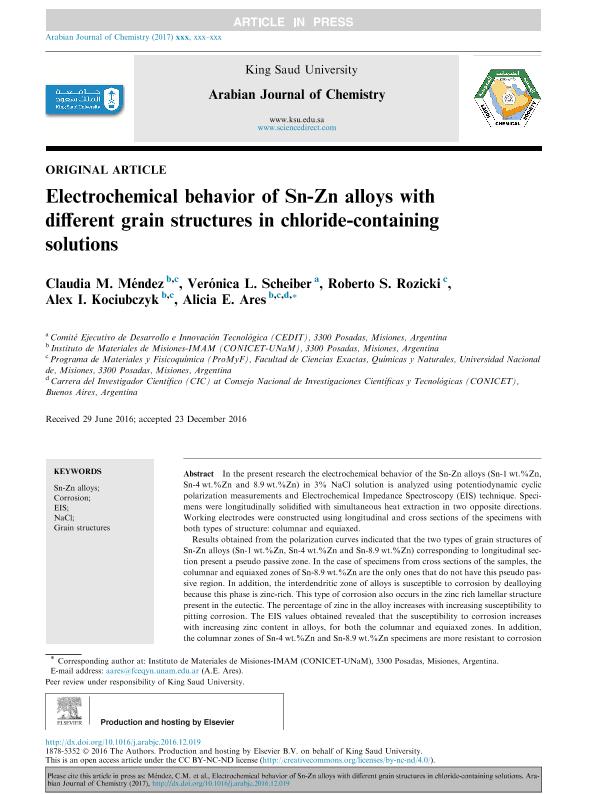Mostrar el registro sencillo del ítem
dc.contributor.author
Mendez, Claudia Marcela

dc.contributor.author
Scheiber, Verónica L.
dc.contributor.author
Rozicki, Roberto S.
dc.contributor.author
Kociubczyk, Alex Iván

dc.contributor.author
Ares, Alicia Esther

dc.date.available
2018-06-05T16:39:35Z
dc.date.issued
2017-01-03
dc.identifier.citation
Mendez, Claudia Marcela; Scheiber, Verónica L.; Rozicki, Roberto S.; Kociubczyk, Alex Iván; Ares, Alicia Esther; Electrochemical behavior of Sn-Zn alloys with different grain structures in chloride-containing solutions; Elsevier; Arabian Journal of Chemistry; 03-1-2017; 1-13
dc.identifier.issn
1878-5352
dc.identifier.uri
http://hdl.handle.net/11336/47321
dc.description.abstract
In the present research the electrochemical behavior of the Sn-Zn alloys (Sn-1 wt.%Zn, Sn-4 wt.%Zn and 8.9 wt.%Zn) in 3% NaCl solution is analyzed using potentiodynamic cyclic polarization measurements and Electrochemical Impedance Spectroscopy (EIS) technique. Specimens were longitudinally solidified with simultaneous heat extraction in two opposite directions. Working electrodes were constructed using longitudinal and cross sections of the specimens with both types of structure: columnar and equiaxed. Results obtained from the polarization curves indicated that the two types of grain structures of Sn-Zn alloys (Sn-1 wt.%Zn, Sn-4 wt.%Zn and Sn-8.9 wt.%Zn) corresponding to longitudinal section present a pseudo passive zone. In the case of specimens from cross sections of the samples, the columnar and equiaxed zones of Sn-8.9 wt.%Zn are the only ones that do not have this pseudo passive region. In addition, the interdendritic zone of alloys is susceptible to corrosion by dealloying because this phase is zinc-rich. This type of corrosion also occurs in the zinc rich lamellar structure present in the eutectic. The percentage of zinc in the alloy increases with increasing susceptibility to pitting corrosion. The EIS values obtained revealed that the susceptibility to corrosion increases with increasing zinc content in alloys, for both the columnar and equiaxed zones. In addition, the columnar zones of Sn-4 wt.%Zn and Sn-8.9 wt.%Zn specimens are more resistant to corrosion than the equiaxed grain specimens. However, the equiaxed zone of Sn-1 wt.%Zn alloy is less susceptible to corrosion than the columnar zone. After adjustment by equivalent circuits it is revealed that the equiaxed zone of Sn-8.9 wt.%Zn alloy has a second porous layer composed of corrosion products on the electrode surface.
dc.format
application/pdf
dc.language.iso
eng
dc.publisher
Elsevier

dc.rights
info:eu-repo/semantics/openAccess
dc.rights.uri
https://creativecommons.org/licenses/by-nc-nd/2.5/ar/
dc.subject
Sn-Zn Alloys
dc.subject
Corrosion
dc.subject
Nacl
dc.subject
Grain Structures
dc.subject
Eis
dc.subject.classification
Recubrimientos y Películas

dc.subject.classification
Ingeniería de los Materiales

dc.subject.classification
INGENIERÍAS Y TECNOLOGÍAS

dc.title
Electrochemical behavior of Sn-Zn alloys with different grain structures in chloride-containing solutions
dc.type
info:eu-repo/semantics/article
dc.type
info:ar-repo/semantics/artículo
dc.type
info:eu-repo/semantics/publishedVersion
dc.date.updated
2018-06-04T17:27:29Z
dc.identifier.eissn
1878-5379
dc.journal.pagination
1-13
dc.journal.pais
Arabia Saudita

dc.journal.ciudad
Riyadh
dc.description.fil
Fil: Mendez, Claudia Marcela. Universidad Nacional de Misiones. Facultad de Ciencias Exactas, Químicas y Naturales; Argentina. Consejo Nacional de Investigaciones Científicas y Técnicas. Centro Científico Tecnológico Conicet - Nordeste. Instituto de Materiales de Misiones. Universidad Nacional de Misiones. Facultad de Ciencias Exactas Químicas y Naturales. Instituto de Materiales de Misiones; Argentina
dc.description.fil
Fil: Scheiber, Verónica L.. Provincia de Misiones. Comité de Desarrollo e Innovación Tecnológica. Centro de Desarrollo e Innovación Tecnológica; Argentina
dc.description.fil
Fil: Rozicki, Roberto S.. Universidad Nacional de Misiones. Facultad de Ciencias Exactas, Químicas y Naturales; Argentina
dc.description.fil
Fil: Kociubczyk, Alex Iván. Universidad Nacional de Misiones. Facultad de Ciencias Exactas, Químicas y Naturales; Argentina. Consejo Nacional de Investigaciones Científicas y Técnicas. Centro Científico Tecnológico Conicet - Nordeste. Instituto de Materiales de Misiones. Universidad Nacional de Misiones. Facultad de Ciencias Exactas Químicas y Naturales. Instituto de Materiales de Misiones; Argentina
dc.description.fil
Fil: Ares, Alicia Esther. Universidad Nacional de Misiones. Facultad de Ciencias Exactas, Químicas y Naturales; Argentina. Consejo Nacional de Investigaciones Científicas y Técnicas. Centro Científico Tecnológico Conicet - Nordeste. Instituto de Materiales de Misiones. Universidad Nacional de Misiones. Facultad de Ciencias Exactas Químicas y Naturales. Instituto de Materiales de Misiones; Argentina
dc.journal.title
Arabian Journal of Chemistry
dc.relation.alternativeid
info:eu-repo/semantics/altIdentifier/doi/https://doi.org/10.1016/j.arabjc.2016.12.019
dc.relation.alternativeid
info:eu-repo/semantics/altIdentifier/url/https://www.sciencedirect.com/science/article/pii/S1878535216302635?via%3Dihub
Archivos asociados
